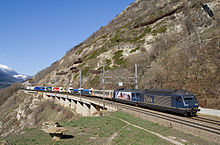
The Société nationale des chemins de fer français is France's national state-owned railway company. Founded in 1938, it operates the country's national rail traffic along with Monaco, including the TGV, on France's high-speed rail network. Its functions include operation of railway services for passengers and freight, as well as maintenance and signalling of rail infrastructure. The railway network consists of about 35,000 km (22,000 mi) of route, of which 2,600 km (1,600 mi) are high-speed lines and 14,500 km (9,000 mi) electrified. About 14,000 trains are operated daily.

Piggyback transportation refers to the transportation of goods where one transportation unit is carried on the back of something else. It is a specialised form of intermodal transportation and combined transport.
Getlink, formerly Groupe Eurotunnel, is a European public company based in Paris that manages and operates the infrastructure of the Channel Tunnel between France and the United Kingdom, operates the LeShuttle railway service, and earns revenue on other trains that operate through the tunnel.
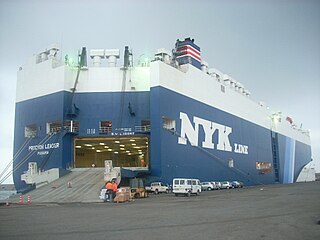
Roll-on/roll-off ships are cargo ships designed to carry wheeled cargo, such as cars, motorcycles, trucks, semi-trailer trucks, buses, trailers, and railroad cars, that are driven on and off the ship on their own wheels or using a platform vehicle, such as a self-propelled modular transporter. This is in contrast to lift-on/lift-off (LoLo) vessels, which use a crane to load and unload cargo.

LeShuttle is a railway shuttle service between Calais in France and Folkestone in United Kingdom. It conveys road vehicles and passengers by rail through the Channel Tunnel. Freight vehicles are carried in separate shuttle trains hauled by the same locomotives, that also contain a passenger carriage, known as the Club Car.

Konkan Railway Corporation Limited (KRCL) is an Indian public sector undertaking which operates Konkan Railway and also undertakes other railway-related projects. It is wholly-owned by the Government of India under the administrative control of the Ministry of Railways and headquartered at CBD Belapur in Navi Mumbai. The railway (railroad) route of KRCL covers the coastal districts of Maharashtra, Goa and Karnataka states of India.
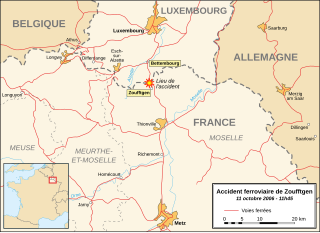
The 2006 Zoufftgen train collision occurred around 11.45 am on 11 October 2006, near Zoufftgen, Moselle, France, some 20 metres from the border with Luxembourg, on the Metz–Luxembourg railway line. Two trains collided head-on while one track of a double track line was out of service for maintenance. Six people, including the drivers of both trains, were killed: two Luxembourgers and four French. Twenty more were injured in the accident, two seriously.
Lorry-Rail is a rolling highway operator. Its mission consists of developing, promoting and marketing the new 1050 km rail-road service from Bettembourg, Luxembourg to le Boulou near Perpignan, France, for standard unaccompanied semi-trailers. It uses Modalohr piggyback wagons.
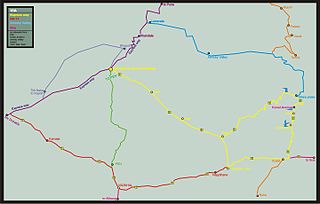
Kolad is a village in Raigad district, Maharashtra State, India. It is 117 km from Mumbai on the National Highway no 66(Mumbai-Goa) its also connected to Pune via Kolad Pune- Kolad state highway. It lies on the banks of River Kundalika. The village post office Postal Index Number is 402304 & 402109.
Veolia Cargo was a European rail freight transportation company that operated mainly in France and Germany. On 2 September 2009, the company was acquired by Eurotunnel and SNCF, the deal being finalised on 1 December 2009.
Europorte Channel is a rail freight train operator which operates rail freight services between France and the United Kingdom through the Channel Tunnel. It is a subsidiary of Europorte.
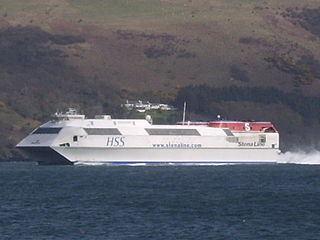
Accompanied combined transport is a form of intermodal transport, which is the movement of goods in one and the same loading unit or road vehicle, using successively two or more modes of transport without handling the goods themselves in changing modes. More specifically, accompanied combined transport is one of the two types of combined transport, which is intermodal transport where the major part of the journey is by rail, inland waterways or sea, and any initial and/or final legs carried out by road are as short as possible.

A car shuttle train, or (sometimes) car-carrying train, is a shuttle train used to transport accompanied cars (automobiles), and usually also bicycles and other types of road vehicles, for a relatively short distance.

Cargobeamer is an intermodal transport system. It involves specially designed pallets which can be carried on a road trailer; the pallets are fitted on top of flatcars but can slide sideways to allow trucks to drive on and off smoothly at intermodal terminals. A first testing terminal was opened in Leipzig in Germany; trial runs between Leipzig and Lithuania were planned in November 2010. Since July 2021, the first full CargoBeamer terminal is available to the public transport market in Calais, France.

MS Al Andalus Express is a freight ferry owned by Eurotunnel and operated by Naviera Armas. She was built in 1987 by Chantiers du Nord et de la Mediterranee, Dunkirk for Societe Nationale des Chemin de Fer Francais (SNCF) as a multi-purpose passenger and roll-on roll-off ferry for lorries and railway vehicles. After the introduction of Eurotunnel there was no need for a train ferry, so SNCF was losing money running her. She was acquired by SNAT and Stena Sealink in 1989, which operated the Nord Pas-de-Calais until 31 December 1995. From 1 January 1996 SNAT operated as SeaFrance. The vessel was renamed SeaFrance Nord Pas-de-Calais. SeaFrance operated until November 2011, and was liquidated on 9 January 2012. Eurotunnel won the bid for the three of the former SeaFrance vessels the original name of the vessel was restored, dropping the SeaFrance prefix. MyFerryLink started running on 20 August 2012, although Nord Pas-de-Calais joined in November 2012 following a refit. Following MyFerryLink's cessation of operations, mostly cited due to financial issues, the ferry was used directly by Eurotunnel to carry hazmat cargoes that are not allowed on regular train services.
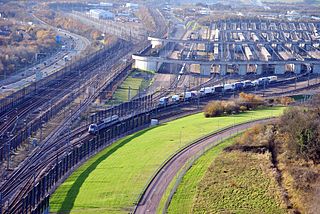
The Eurotunnel Folkestone Terminal is a railway terminal built for the transport of road-going vehicles on specially constructed trains through the Channel Tunnel. The station is located in Cheriton, a northern suburb of the town of Folkestone in the county of Kent. It is the terminal for the United Kingdom. On the French side is the Eurotunnel Calais Terminal located at Coquelles, near Calais. The passenger service building at the Eurotunnel Folkestone Terminal is called the Victor Hugo Terminal, named for the French author Victor Hugo.

The Lohr Railway System or Modalohr System uses special railway wagons of a type known as piggyback wagons, to carry standard road semi-trailers on the European rail network. They are currently used on the AFF route from France to Italy and Luxembourg to the French border with Spain and vice versa. There are plans to expand this service. They have also been approved for the Channel Tunnel. This articulated railway wagon consists of two low-floor decks, resting on a single Y25 jacobs bogie in the middle and on two Y33 bogies on the extreme ends. Using standard bogies resulted in lower maintenance costs compared with the similar rolling highway concept. The deck between the bogies (trucks) pivots (swings) 30°, allowing the trailers to be loaded from the sides. The cars are built by Lohr Industrie.

The Eurotunnel Calais Terminal is a railway terminal built for the transport of road-going vehicles on specially constructed trains through the Channel Tunnel. The station is located in the commune of Coquelles in the Pas-de-Calais department near the city of Calais. It is the terminal for the France and by extension the rest of Continental Europe. On the British side is the Eurotunnel Folkestone Terminal located at Cheriton, near Folkestone. The passenger service building at the Eurotunnel Folkestone Terminal is called the Charles Dickens Terminal, named for the British author Charles Dickens.
The Alpine rolling highway is a combined transport service, in the form of a rolling highway on special wagons traveling a distance of 175 km between France and Italy by the Mont Cenis Tunnel.
